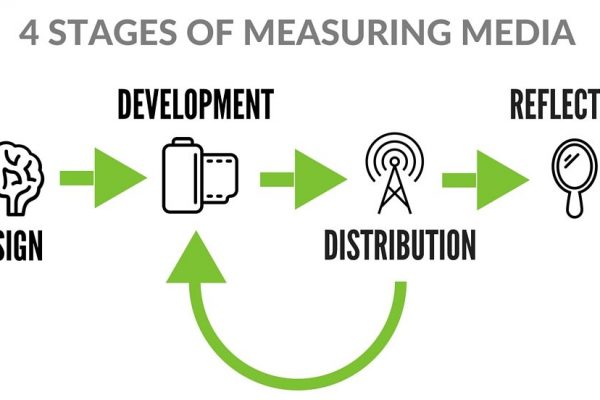Be SMART: Designing Effective Media Campaigns (Stage 1)
Why are funding organizations looking more and more toward media as a valuable method to affect social change?
Because it has been shown to work.
There are four key stages in the use of media. These stages include design, development, distribution and reflection. In this piece, we discuss the importance of design and the impact evaluation can have in this stage in creating a successful campaign, and subsequently detail the process.
With poor planning and clarity of design, media campaign efforts can result in less than desirable outcomes. Some studies have shown that the lack of knowledge around potential impact has resulted in at best, wasted funds (take AT&T as an example). Or worse, it may have the opposite effect from what was intended.
These projects could have been enhanced with the support of evaluative techniques – specifically in planning and design. George Perlov does a great job of outlining the relationship between good communication campaigns and behavior change in his work “Driving Behavior Change Through Communications: Campaign Insights, Successes, and Lessons Learned.” In his report, Perlov identified two key critical pieces in the design phase that – if ignored – can prevent an effective campaign to affect social change: adequate planning and having clearly defined outcomes and metrics. Both of which are evaluative techniques.
Commercial media has been highly successful in developing campaigns to sell. Many of these companies are informed by evaluation. By engaging an evaluator as early as the design phase of a media campaign, media sponsors and producers increase their chances of influencing their intended audiences.
There are four critical steps in the design stage for media production:
- Identify the goals/purpose of the media campaign
- Conduct audience research
- Identify the goals/purpose of individual content pieces
- Develop a preliminary content plan and timeline
1. Identify the goals/purpose of the media campaign
In this step, the producer(s), sponsor(s), and an evaluator meet to discuss what the project is expected to accomplish. This is the moment where the most deliberate conversations of the project must take place in order to agree on the goals. The roll of the evaluator is to help the team focus on the goals and clearly articulate them. This process helps focus the content as well as ensure that the sponsors and producers have aligned expectations. Ideally, SMART goals are generated, these are:
- Specific
- Measurable
- Agreed upon
- Realistic
- Time-based
Often, without the help of an evaluator, producers of the content and sponsors determine a date to end the project, but the goals themselves are only roughly articulated.
Until recently, impact has mostly been measured in terms of the number of people who have seen or heard the content (i.e., views of content). The underlying assumption from the producers is that if they tell a compelling story, the target audience will be affected. Counting individuals that have experienced the content tied with this assumption is how media impact has been measured for decades. Often, this assumption is wrong. Philip Napoli of Rutgers University shows in his paper, “Measuring Media Impact: An Overview of the Field” that this is in fact a rudimentary measure of engagement. While a critical step, it should be differentiated from impact. By engaging with an evaluator at the onset, SMART goals for the project can be generated, assumptions can be clarified, and clear measures of impact can be determined. Without this support, producers can understate or overstate the potential effects of their work. This can result in missing assumed levels of effect or missing the true impact of the content, often resulting in disappointment for the sponsors.
2. Conduct audience research
We have a set of SMART goals, but do they make sense given the target audience? This is where the evaluator provides the most unique information. They use their skills to understand the position of the targeted audience relative to the goals of the project. Depending on the skill set of the evaluator, the needs of the producers, and the information desired – various methods of information collection might be used. These could include surveys, focus groups, interviews, or observations of the environment. Some might consider placing this process ahead of the goal development. However, the identification of the target audience usually emerges with the development of the SMART goals as well as articulation of the actual expected effects. With a clear understanding of the purpose of the media campaign, valuable data can be collected to assess assumptions.
Armed with the information uncovered by the evaluator, the producers and sponsors can further clarify, refine, or revise project goals. Timelines might be shifted, and agreement can be reached as to what measures will be used to determine the impact of the project.
3. Identify the goals/purpose of individual content pieces and how they fit together
As mentioned previously, individual pieces of produced content can and do influence those exposed to them, but often producers and viewers/listeners incorrectly assume that one piece of content resulted in change. Rather, it is a complex road – as I addressed in an earlier blog post. Savvy sponsors and producers will look across many potential pieces of media and consider which combinations make the most sense. Is it a series of short posts on various websites that precede a longer broadcast show? Is it a series of podcasts that added together can move an audience? Form and function of each piece, combined with a sense of what the sponsors and producers want the audience to take away from the experience should inform this process. It is here that the producers might step away from the sponsors, having agreed upon the larger goals of the effort, to work with an evaluator to outline content ideas to achieve the goals of the project.
Insights derived from audience research help the producers understand the position of their audience. If a majority is still not aware of the issue, production of content focused on moving them to action will be ineffective. If the audience understands the issue and is emotionally engaged, less effort needs to be expended to increasing awareness. Informed by this, the producers develop their content ideas, including information to be conveyed, potential sources for content (location, individuals), and types of content (print, video, audio, other). For each piece, the producers identify what the specific goal of the content is:
- Increase awareness
- Elicit greater understanding
- Evoke an emotional response
- Direct people to act
4. Develop a preliminary content plan and timeline
The producers take their content ideas and develop a plan for development and distribution. Tied to a timeline and estimates of how effective each piece of content can be, the producers outline the strategy to influence their audience. The strategy should not be set in stone. Rather, the strategy should be flexible – allowing for changes to occur as the impact of the content is measured through the course of the campaign due to various factors. Other events or content may also influence the audience. The content might not be as effective as expected, or it might be too effective. As such, the producers and sponsors are cautioned to only develop a rough plan and collaborate with their evaluator in assessing impact during the distribution phase.
Do you have a clearly designed process for content development? Do you currently use an evaluation expert to help in this process? If not, you might be missing opportunities to imagine, design, implement, and assess effective, high-impact media campaigns.
In an upcoming blog post, we will discuss Stage 2 of measuring media outcomes – development – and explain how evaluation can ensure content is right for the audience and have its intended effects.
Want to learn more about media evaluation services & tools? Email the author Charles Gasper: cgasper@tccgrp.com.



